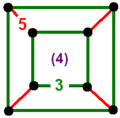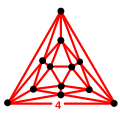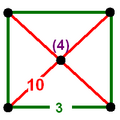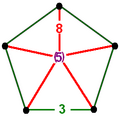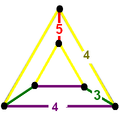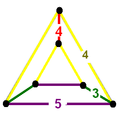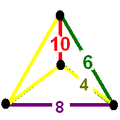Uniform honeycombs in hyperbolic space

In hyperbolic geometry, a uniform honeycomb in hyperbolic space is a uniform tessellation of uniform polyhedral cells. In 3-dimensional hyperbolic space there are nine Coxeter group families of compact convex uniform honeycombs, generated as Wythoff constructions, and represented by permutations of rings of the Coxeter diagrams for each family.
 Order-4 dodecahedral honeycomb {5,3,4} |  Order-5 dodecahedral honeycomb {5,3,5} |
 Order-5 cubic honeycomb {4,3,5} |  Icosahedral honeycomb {3,5,3} |
| Poincaré ball model projections | |
|---|---|
Hyperbolic uniform honeycomb families
[edit]Honeycombs are divided between compact and paracompact forms defined by Coxeter groups, the first category only including finite cells and vertex figures (finite subgroups), and the second includes affine subgroups.
Compact uniform honeycomb families
[edit]The nine compact Coxeter groups are listed here with their Coxeter diagrams,[1] in order of the relative volumes of their fundamental simplex domains.[2]
These 9 families generate a total of 76 unique uniform honeycombs. The full list of hyperbolic uniform honeycombs has not been proven and an unknown number of non-Wythoffian forms exist. Two known examples are cited with the {3,5,3} family below. Only two families are related as a mirror-removal halving: [5,31,1] ↔ [5,3,4,1+].
| Indexed | Fundamental simplex volume[2] | Witt symbol | Coxeter notation | Commutator subgroup | Coxeter diagram | Honeycombs |
|---|---|---|---|---|---|---|
| H1 | 0.0358850633 | [5,3,4] | [(5,3)+,4,1+] = [5,31,1]+ | 15 forms, 2 regular | ||
| H2 | 0.0390502856 | [3,5,3] | [3,5,3]+ | 9 forms, 1 regular | ||
| H3 | 0.0717701267 | [5,31,1] | [5,31,1]+ | 11 forms (7 overlap with [5,3,4] family, 4 are unique) | ||
| H4 | 0.0857701820 | [(4,3,3,3)] | [(4,3,3,3)]+ | 9 forms | ||
| H5 | 0.0933255395 | [5,3,5] | [5,3,5]+ | 9 forms, 1 regular | ||
| H6 | 0.2052887885 | [(5,3,3,3)] | [(5,3,3,3)]+ | 9 forms | ||
| H7 | 0.2222287320 | [(4,3)[2]] | [(4,3+,4,3+)] | 6 forms | ||
| H8 | 0.3586534401 | [(3,4,3,5)] | [(3,4,3,5)]+ | 9 forms | ||
| H9 | 0.5021308905 | [(5,3)[2]] | [(5,3)[2]]+ | 6 forms |
There are just two radical subgroups with non-simplicial domains that can be generated by removing a set of two or more mirrors separated by all other mirrors by even-order branches. One is [(4,3,4,3*)], represented by Coxeter diagrams ![]()
![]()
![]()
![]() an index 6 subgroup with a trigonal trapezohedron fundamental domain ↔
an index 6 subgroup with a trigonal trapezohedron fundamental domain ↔ ![]()
![]()
![]()
![]()
![]()
![]()
![]() , which can be extended by restoring one mirror as
, which can be extended by restoring one mirror as ![]()
![]()
![]()
![]()
![]() . The other is [4,(3,5)*], index 120 with a dodecahedral fundamental domain.
. The other is [4,(3,5)*], index 120 with a dodecahedral fundamental domain.
Paracompact hyperbolic uniform honeycombs
[edit]There are also 23 paracompact Coxeter groups of rank 4 that produce paracompact uniform honeycombs with infinite or unbounded facets or vertex figure, including ideal vertices at infinity.
| Type | Coxeter groups |
|---|---|
| Linear graphs | |
| Tridental graphs | |
| Cyclic graphs | |
| Loop-n-tail graphs |
Other paracompact Coxeter groups exists as Vinberg polytope fundamental domains, including these triangular bipyramid fundamental domains (double tetrahedra) as rank 5 graphs including parallel mirrors. Uniform honeycombs exist as all permutations of rings in these graphs, with the constraint that at least one node must be ringed across infinite order branches.
| Dimension | Rank | Graphs |
|---|---|---|
| H3 | 5 |
|
[3,5,3] family
[edit]There are 9 forms, generated by ring permutations of the Coxeter group: [3,5,3] or ![]()
![]()
![]()
![]()
![]()
![]()
![]()
One related non-wythoffian form is constructed from the {3,5,3} vertex figure with 4 (tetrahedrally arranged) vertices removed, creating pentagonal antiprisms and dodecahedra filling in the gaps, called a tetrahedrally diminished dodecahedron.[3] Another is constructed with 2 antipodal vertices removed.[4]
The bitruncated and runcinated forms (5 and 6) contain the faces of two regular skew polyhedrons: {4,10|3} and {10,4|3}.
| # | Honeycomb name Coxeter diagram and Schläfli symbols | Cell counts/vertex and positions in honeycomb | Vertex figure | Picture | |||
|---|---|---|---|---|---|---|---|
| 0 | 1 | 2 | 3 | ||||
| 1 | icosahedral (ikhon) t0{3,5,3} | (12) (3.3.3.3.3) |  |  | |||
| 2 | rectified icosahedral (rih) t1{3,5,3} | (2) (5.5.5) | (3) (3.5.3.5) | 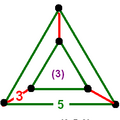 |  | ||
| 3 | truncated icosahedral (tih) t0,1{3,5,3} | (1) (5.5.5) | (3) (5.6.6) | 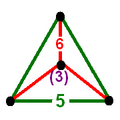 |  | ||
| 4 | cantellated icosahedral (srih) t0,2{3,5,3} | (1) (3.5.3.5) | (2) (4.4.3) | (2) (3.5.4.5) |  |  | |
| 5 | runcinated icosahedral (spiddih) t0,3{3,5,3} | (1) (3.3.3.3.3) | (5) (4.4.3) | (5) (4.4.3) | (1) (3.3.3.3.3) |  |  |
| 6 | bitruncated icosahedral (dih) t1,2{3,5,3} | (2) (3.10.10) | (2) (3.10.10) |  |  | ||
| 7 | cantitruncated icosahedral (grih) t0,1,2{3,5,3} | (1) (3.10.10) | (1) (4.4.3) | (2) (4.6.10) | 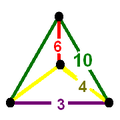 |  | |
| 8 | runcitruncated icosahedral (prih) t0,1,3{3,5,3} | (1) (3.5.4.5) | (1) (4.4.3) | (2) (4.4.6) | (1) (5.6.6) |  |  |
| 9 | omnitruncated icosahedral (gipiddih) t0,1,2,3{3,5,3} | (1) (4.6.10) | (1) (4.4.6) | (1) (4.4.6) | (1) (4.6.10) | 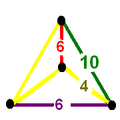 |  |
| # | Honeycomb name Coxeter diagram and Schläfli symbols | Cell counts/vertex and positions in honeycomb | Vertex figure | Picture | ||||
|---|---|---|---|---|---|---|---|---|
| 0 | 1 | 2 | 3 | Alt | ||||
| [77] | partially diminished icosahedral (pidih) pd{3,5,3}[5] | (12) (3.3.3.5) | (4) (5.5.5) | 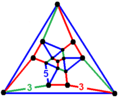 |  | |||
| [78] | semi-partially diminished icosahedral spd{3,5,3}[4] | (6) (3.3.3.5) (6) (3.3.3.3.3) | (2) (5.5.5) | |||||
| Nonuniform | omnisnub icosahedral (snih) ht0,1,2,3{3,5,3} | (1) (3.3.3.3.5) | (1) (3.3.3.3 | (1) (3.3.3.3) | (1) (3.3.3.3.5) | (4) +(3.3.3) | 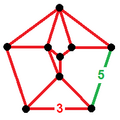 | |
[5,3,4] family
[edit]There are 15 forms, generated by ring permutations of the Coxeter group: [5,3,4] or ![]()
![]()
![]()
![]()
![]()
![]()
![]() .
.
This family is related to the group [5,31,1] by a half symmetry [5,3,4,1+], or ![]()
![]()
![]()
![]()
![]() ↔
↔ ![]()
![]()
![]()
![]()
![]()
![]()
![]() , when the last mirror after the order-4 branch is inactive, or as an alternation if the third mirror is inactive
, when the last mirror after the order-4 branch is inactive, or as an alternation if the third mirror is inactive ![]()
![]()
![]()
![]()
![]() ↔
↔ ![]()
![]()
![]()
![]()
![]()
![]()
![]() .
.
| # | Name of honeycomb Coxeter diagram | Cells by location and count per vertex | Vertex figure | Picture | |||||
|---|---|---|---|---|---|---|---|---|---|
| 0 | 1 | 2 | 3 | Alt | |||||
| [34] | alternated order-5 cubic (apech) | (20) (3.3.3) | (12) (3.3.3.3.3) |  |  | ||||
| [35] | cantic order-5 cubic (tapech) | (1) (3.5.3.5) | - | (2) (5.6.6) | (2) (3.6.6) | 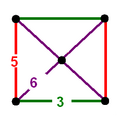 |  | ||
| [36] | runcic order-5 cubic (birapech) | (1) (5.5.5) | - | (3) (3.4.5.4) | (1) (3.3.3) |  |  | ||
| [37] | runcicantic order-5 cubic (bitapech) | (1) (3.10.10) | - | (2) (4.6.10) | (1) (3.6.6) |  |  | ||
| Nonuniform | snub rectified order-4 dodecahedral | (1) (3.3.3.3.3) | (1) (3.3.3) | - | (2) (3.3.3.3.5) | (4) +(3.3.3) | 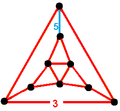 Irr. tridiminished icosahedron | ||
| Nonuniform | runcic snub rectified order-4 dodecahedral | (3.4.4.4) | (4.4.4.4) | - | (3.3.3.3.5) | +(3.3.3) | |||
| Nonuniform | omnisnub order-5 cubic | (1) (3.3.3.3.4) | (1) (3.3.3.4) | (1) (3.3.3.5) | (1) (3.3.3.3.5) | (4) +(3.3.3) |  | ||
[5,3,5] family
[edit]There are 9 forms, generated by ring permutations of the Coxeter group: [5,3,5] or ![]()
![]()
![]()
![]()
![]()
![]()
![]()
The bitruncated and runcinated forms (29 and 30) contain the faces of two regular skew polyhedrons: {4,6|5} and {6,4|5}.
| # | Name of honeycomb Coxeter diagram | Cells by location and count per vertex | Vertex figure | Picture | |||
|---|---|---|---|---|---|---|---|
| 0 | 1 | 2 | 3 | ||||
| 25 | (Regular) Order-5 dodecahedral (pedhon) t0{5,3,5} | (20) (5.5.5) |  |  | |||
| 26 | rectified order-5 dodecahedral (ripped) t1{5,3,5} | (2) (3.3.3.3.3) | (5) (3.5.3.5) |  |  | ||
| 27 | truncated order-5 dodecahedral (tipped) t0,1{5,3,5} | (1) (3.3.3.3.3) | (5) (3.10.10) |  |  | ||
| 28 | cantellated order-5 dodecahedral (sripped) t0,2{5,3,5} | (1) (3.5.3.5) | (2) (4.4.5) | (2) (3.5.4.5) |  |  | |
| 29 | Runcinated order-5 dodecahedral (spidded) t0,3{5,3,5} | (1) (5.5.5) | (3) (4.4.5) | (3) (4.4.5) | (1) (5.5.5) |  |  |
| 30 | bitruncated order-5 dodecahedral (diddoh) t1,2{5,3,5} | (2) (5.6.6) | (2) (5.6.6) |  |  | ||
| 31 | cantitruncated order-5 dodecahedral (gripped) t0,1,2{5,3,5} | (1) (5.6.6) | (1) (4.4.5) | (2) (4.6.10) |  |  | |
| 32 | runcitruncated order-5 dodecahedral (pripped) t0,1,3{5,3,5} | (1) (3.5.4.5) | (1) (4.4.5) | (2) (4.4.10) | (1) (3.10.10) | 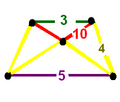 |  |
| 33 | omnitruncated order-5 dodecahedral (gipidded) t0,1,2,3{5,3,5} | (1) (4.6.10) | (1) (4.4.10) | (1) (4.4.10) | (1) (4.6.10) |  |  |
| # | Name of honeycomb Coxeter diagram | Cells by location and count per vertex | Vertex figure | Picture | ||||
|---|---|---|---|---|---|---|---|---|
| 0 | 1 | 2 | 3 | Alt | ||||
| Nonuniform | omnisnub order-5 dodecahedral ht0,1,2,3{5,3,5} | (1) (3.3.3.3.5) | (1) (3.3.3.5) | (1) (3.3.3.5) | (1) (3.3.3.3.5) | (4) +(3.3.3) |  | |
[5,31,1] family
[edit]There are 11 forms (and only 4 not shared with [5,3,4] family), generated by ring permutations of the Coxeter group: [5,31,1] or ![]()
![]()
![]()
![]()
![]() . If the branch ring states match, an extended symmetry can double into the [5,3,4] family,
. If the branch ring states match, an extended symmetry can double into the [5,3,4] family, ![]()
![]()
![]()
![]()
![]() ↔
↔ ![]()
![]()
![]()
![]()
![]()
![]()
![]() .
.
| # | Honeycomb name Coxeter diagram | Cells by location (and count around each vertex) | vertex figure | Picture | |||
|---|---|---|---|---|---|---|---|
| 0 | 1 | 0' | 3 | ||||
| 34 | alternated order-5 cubic (apech) | - | - | (12) (3.3.3.3.3) | (20) (3.3.3) |  |  |
| 35 | cantic order-5 cubic (tapech) | (1) (3.5.3.5) | - | (2) (5.6.6) | (2) (3.6.6) |  |  |
| 36 | runcic order-5 cubic (birapech) | (1) (5.5.5) | - | (3) (3.4.5.4) | (1) (3.3.3) |  |  |
| 37 | runcicantic order-5 cubic (bitapech) | (1) (3.10.10) | - | (2) (4.6.10) | (1) (3.6.6) |  |  |
| # | Honeycomb name Coxeter diagram | Cells by location (and count around each vertex) | vertex figure | Picture | |||
|---|---|---|---|---|---|---|---|
| 0 | 1 | 3 | Alt | ||||
| [10] | Order-4 dodecahedral (doehon) | (4) (5.5.5) | - | - |  |  | |
| [11] | rectified order-4 dodecahedral (riddoh) | (2) (3.5.3.5) | - | (2) (3.3.3.3) |  |  | |
| [12] | rectified order-5 cubic (ripech) | (1) (3.3.3.3.3) | - | (5) (3.4.3.4) | 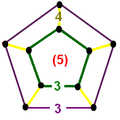 |  | |
| [15] | bitruncated order-5 cubic (ciddoh) | (1) (5.6.6) | - | (2) (4.6.6) |  |  | |
| [14] | truncated order-4 dodecahedral (tiddoh) | ||||||









